#portfolio Ukiyo-E
Photo

Portfolio Ukiyo-E, Sergio Toppi, disponible sur entre-image.com
90 notes
·
View notes
Text



Goatsucker (飲山羊乳者)
The nightjar hangs close to the sheep or goat, to suckle milk at the breast. In turn the sheep eagerly awaits the night, and her nightjar's whisper of newfound secrets.
An art style study I did based on Takato Yamamoto (山本タカト), known for his heisei aesthetic paintings (a fusion of Japanese ukiyo-e x gothic art).
Takato Yamamoto's line drawings are solidly constructed, a blend of detailed nature and smooth, realistic faces. Though, his compositions typically frame characters up closer to bring out the beauty of their faces.
The eyes are often monolid in shape, with a red underline and colorless irises.
Characters, Artwork © EerieAyres
#artists on tumblr#takato yamamoto#ukiyoe#ukiyo-e#art style challenge#art challenge#heisei estheticism#original character#japanese art#woodblock print#gothic#goth art#goth aesthetic#art history#classical art#art study#art style#my art#painting#portfolio
31 notes
·
View notes
Text
Another fave from The Met's #KimonoStyle show for #FrockFriday + bonus #FroggyFriday:

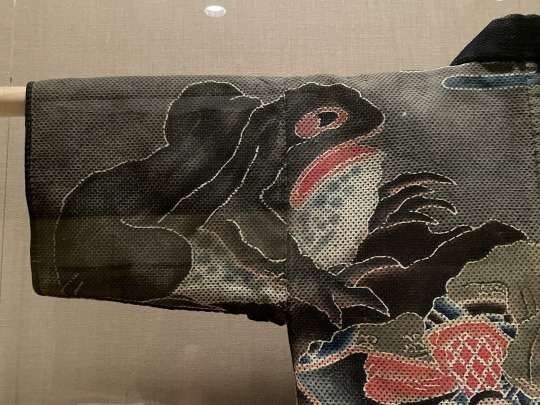

Fireman's Jacket (Hikeshi-banten) w/ Shogun Taro Yoshikado
Japan, Edo period (1615-1868), mid-19th century
Quilted cotton with tube-drawn paste-resist dyeing (tsutsugaki) with hand-painted details
John C. Weber Collection
“[The jacket] features a scene popular in Kabuki & based on a print by Utagawa Kunisada (1786-1865) in which the warrior Yoshikado asks a frog sage for magical powers to avenge the murder of his father.” This is that print:

Utagawa Kunisada (Japanese, 1786-1865)
"Actor Nakamura Shikan IV as Shōgun Tarō Yoshikado"
1862, 12th lunar month
Publisher: Hiranoya Shinzō
Dimensions: 14 9/16 × 9 3/4 in. (36.99 × 24.77 cm) (image, vertical ōban)
Print (ukiyo-e / yakusha-e); Woodblock print (nishiki-e); ink and color on paper
Portfolio: From Toyokuni's Drawings: A Magic Contest (Toyokuni kigō: Kijutsu kurabe 豊国揮毫 奇術競)
Minneapolis Institute of Art 2016.137.2
BTW that “frog sage” is Gama Sennin, the Toad Immortal; here is another woodblock print (actually a triptych) by the same artist of the same legend:
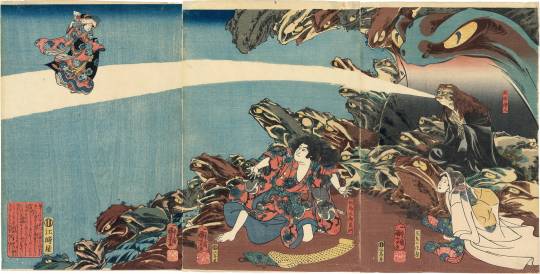
Utagawa Kunisada (Japanese, 1786-1865)
“Gama Sennin Instructing Yoshikado and Takiyasha," 1845
ôban triptych (38 x 77.5 cm)
“Gama Sennin is the toad immortal, and here they appear almost like an old woman, with their long hair fashioned from a toad-faced pelt and appearing in a toad-like body. Here the magician demonstrates their magic, causing the image of a young woman to materialize on their breath. Gama Sennin, the Toad Immortal, is based upon the Chinese Immortal Liu Hai, the Sage with the Toad on his back, a benign sage with great magical powers. Kuniyoshi has outdone himself with the cave of Gama Sennin, as all the rocklike outcroppings are comprised of frogs, and a giant frog spectre hovers over the magician. In the center panel, Yoshikado has been consulting a scroll of some sort, and looks up in surprise, his hands in the ‘astonished’ gesture that Kuniyoshi favored. The motivation of the two young people is of course vengeance for a murdered loved one. A scarce design.”
image & info via https://egenolfgallery.com/products/kuniyoshi-gama-sennin-and-frog-magic
#frog#toad#amphibians#Japanese art#East Asian art#19th century art#historical costume#textiles#garment#Hikeshi-banten#Utagawa Kunisada#Taro Yoshikado#Kabuki#Gama Sennin#frog sage#toad sage#Toad Immortal#Japanese mythology#Japanese folklore#John C Weber Collection#Metropolitan Museum of Art New York#Kimono Style#exhibition#museum visit#Frock Friday#Froggy Friday#animals in art
41 notes
·
View notes
Text
CALL FOR SUBMISSIONS
INKBRUSHMOOD is now accepting artwork + art appreciation submissions!
JAPANESE ART APPRECIATION + HISTORY
We are now accepting brief articles about:
Japanese Art/Movements
Ukiyo-e and its subcategories (i.e. Bijin-ga, Shin hanga)
Japanese photography or graphic design
Please include in your post:
1) A high quality image of what you wish to appreciate. No format restrictions as of yet, but should ideally be JPG or PNG.
2) Caption the image as follows:
ARTIST NAME: Title (in italics), date (in parenthesis). You may include additional information such as canvas size and medium beneath the initial caption.
3) Brief description of stand-out elements of the image. What caught your attention? Point to that or to your favorite aspects of the image. Keep it simple. Off-beat references to Western art or other disciplines are great! Somewhere between 1-2 paragraphs would be ideal, but more is acceptable depending on content.
ORIGINAL ART
Are you a graphic artist influenced by Japanese art? If so, we look forward to receiving your work!
IKB is looking for:
Illustrations
Paintings
Photography
Graphic design experimentation
Formats of your choosing, but try to keep images high quality, JPG or PNG. Ideal post size for Tumblr is 4813px * 4692px. You don't have to explain your artwork, but make sure to caption it:
YOUR NAME: Artwork Title (date of completion). Medium and canvas size (if applicable). Link to portfolio if you have it.
Online submissions only at the moment. Print submissions will open depending on need and reception of call. Online submissions will be featured on Tumblr!IKB as they are approved. Stand-out submissions will be featured in IKB VOL. 2.
To send your work, go to https://inkbrushmood.tumblr.com/submit.
Please feel free to share!
Thank you!
-IKB
#japanese art#illustration#graphic design#photography#ukiyo-e#art#nature#painting#inkbrushmood.com#ikb vol. 2#inkbrushmood submissions
5 notes
·
View notes
Text
Shrouded Fable Expansion Set
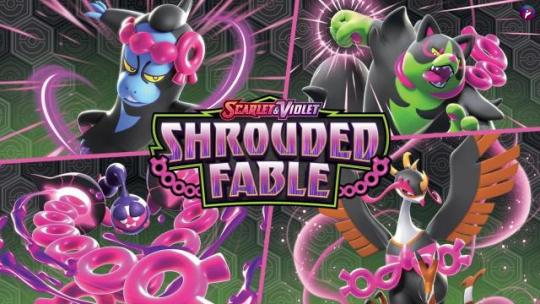

"Shrouded Fable" Special Pokémon TCG Set Revealed for August!
Exciting news for Pokémon TCG fans! The Pokémon Company has unveiled "Shrouded Fable," a special English set scheduled for release on August 2nd, 2024. This set is based on Japan's "Night Wanderer" set and will feature an array of captivating cards, including the powerful Pecharunt ex, Okidogi ex, Munkidori ex, and Fezandipiti ex.
Key Features of Shrouded Fable:
- Over 95 cards in total.
- Three ACE SPEC rare Trainer cards.
- Five Pokémon ex and one Tera Pokémon ex (a Lightning-type Revaroom ex).
- 15 illustration rare Pokémon.
- 10 ultra rare Pokémon ex, Tera Pokémon ex, and Supporter cards.
- Five special illustration rare Pokémon and Supporter cards.
- Five hyper rare gold etched cards.
The set's reverse holo cards will boast a new, unique foil pattern that enhances the card artwork, adding a fresh visual appeal for collectors and players alike.
Set Description:
"Rumors swirl and memories deceive as the march of time beats on in the land of Kitakami! Prepare for nightfall and discover a malevolent presence as Pecharunt ex commands the Loyal Three—Okidogi ex, Munkidori ex, and Fezandipiti ex—to do its nefarious bidding. Meanwhile, Revaroom ex plugs into the grid to Terastallize into a Lightning type, and Kingdra ex makes a royal splash in the Pokémon TCG: Scarlet & Violet—Shrouded Fable expansion!"
Availability and Product Details:
As with all special sets, Shrouded Fable booster packs will not be sold individually but will be available through various products, most of which release on August 2nd:
- Shrouded Fable Pokémon Center Elite Trainer Box:
- Includes 11 booster packs, two copies of an illustration rare-style promo card featuring Pecharunt (one with the Pokémon Center logo), and various gameplay accessories.

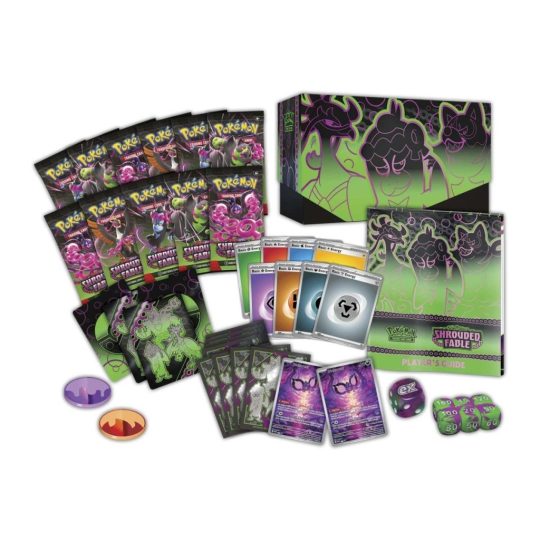
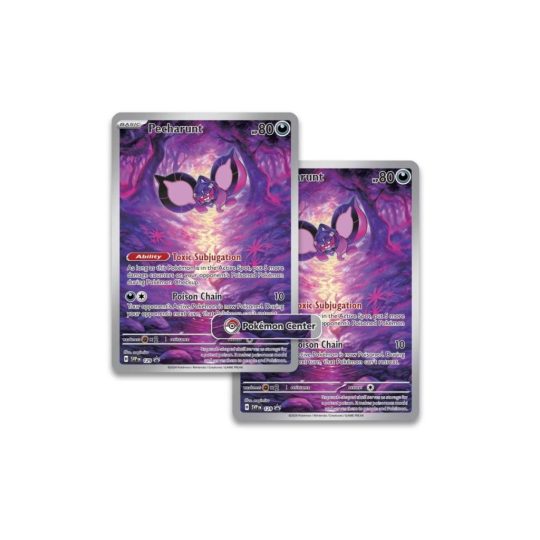
- Shrouded Fable Elite Trainer Box:
- Includes nine booster packs, one illustration rare-style promo card featuring Pecharunt, and various gameplay accessories.
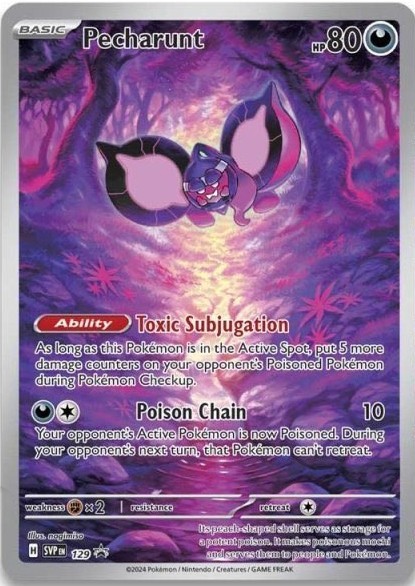
- Shrouded Fable Greninja ex Special Illustration Collection:
- Includes five booster packs, one special illustration rare-style promo card featuring Greninja ex in Ukiyo-e art style, and two foil promo cards featuring Froakie and Frogadier (alternate art reprint and direct reprints from Obsidian Flames).

- Shrouded Fable Kingdra ex Special Illustration Collection:
- Includes five booster packs, one special illustration rare-style promo card featuring Kingdra ex in Ukiyo-e art style, and two foil promo cards featuring Horsea and Seadra (brand new cards, hidden from the product image).
- Shrouded Fable Kingambit Illustration Collection:
- Includes four booster packs, one illustration rare-style promo card featuring Kingambit in Ukiyo-e art style, and two foil promo cards featuring Pawniard and Bisharp (alternate art reprint and direct reprints from Obsidian Flames).
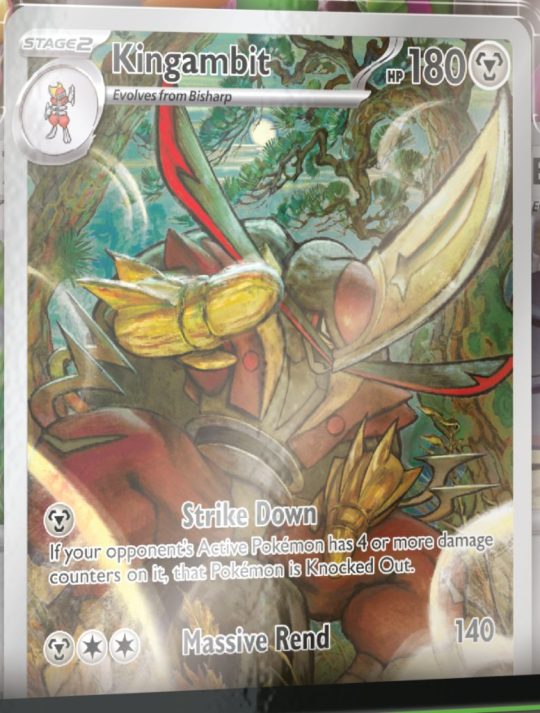
- Shrouded Fable Three-Booster Pack and Promo Card Blister:
- Includes three booster packs and one foil promo card featuring Pecharunt.
- Shrouded Fable Mini Tin:
- Includes two booster packs, one sticker sheet, and one art card featuring Dusknoir, Zoroark, Okidogi, Munkidori, or Fezandipiti.
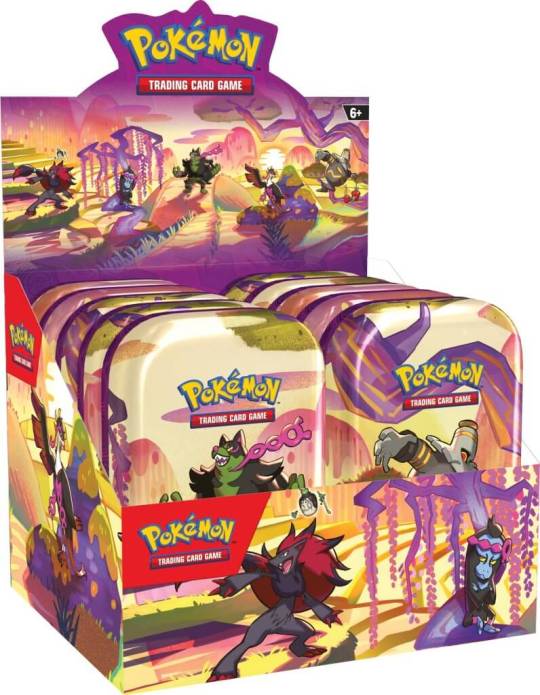
- Shrouded Fable Booster Bundle:
- Includes six booster packs.

Additionally, Ultra PRO will release their usual 4 and 9-pocket portfolios featuring artwork from the set, perfect for collectors to showcase their cards.
Special Card Inclusions:
The set will feature five gold cards. Given that "Night Wanderer" includes three gold cards, it is likely that the gold Darkness and Metal Energy cards cut from the "Paradox Rift" set will be included. Furthermore, illustration rares of the Loyal Three, originally cut from the "Twilight Masquerade" set, are expected to be part of Shrouded Fable's set list.





Legal for Worlds:
Shrouded Fable will be legal for play in time for the Pokémon World Championships, scheduled from August 16th to 18th, 2024. This timing allows competitive players to incorporate these new cards into their strategies for the prestigious event.
Mark your calendars for August 2nd and get ready to delve into the mysteries of "Shrouded Fable," a set that promises to enchant and challenge both collectors and competitive players in the Pokémon TCG community!
Read the full article
#Pokemon#Pokémon#pokemoncenter#pokemoncollector#pokemoncommunity#pokemonfan#pokemongame#pokemontrainer
0 notes
Text
"Octopus Vangst in de Provincie Senshu" stands out among Kuniyoshi's portfolio. This piece steps away from the familiar human narratives that frequent his work and brings forth a scene straight from nature: an octopus hunting scene.
On the surface, the piece seems almost minimalist compared to his other works. It features an octopus with a determined gaze in the blue abyss of the sea. Kuniyoshi perfectly illustrates the fluid movement of the creature, its arms curling and twisting with an almost ethereal grace. The delicate portrayal of the octopus speaks volumes about Kuniyoshi's command over the ukiyo-e style and his keen observation of the natural world.
However, to simply perceive it as a hunting scene would be a gross underestimation of the depth that this work carries. In the background of the ocean's vastness, the painting hints at the timeless struggle for survival that is integral to the natural world. The octopus, in its quest for food, becomes a symbolic representation of the inexorable cycle of life and death, a theme prevalent in many Japanese artworks.
#art#culture#art history#artwork#painter#painting#artblog#wall art#home decor#asian art#asian#asian culture#asian artist#japan#japanese artist#japanese culture#japanese#japan art#japanese art#utagawa kuniyoshi#Octopus Vangst in de Provincie Senshu#ukiyo e
0 notes
Photo

Boy Kong.’s tigers come in different shapes, styles and mediums! The artist employs perspectives from all corners of this world: “Inspired by a mixture of Ukiyo-e, Surrealism, Graffiti art, and animal folklore”, he creates unique pieces that represent the versatility and complexity of Boykong’s portfolio.
---
#beautifulbizarre #boykong #watercolour #sumiink #tiger #artist #visualart #art #expression #traditionalart #instaartist #contemporaryart #newcontemporary
115 notes
·
View notes
Photo








Yoshitaka Amano - Art of Final Fantasy
Yoshitaka Amano, born 1952 in Shizuka, Japan, is one of Japan’s most-renowned artists and illustrators. He also began his career as a character designer for early anime shows like Speed Racer, Gatchaman and Tekkaman. He would continue to build on his portfolio of unique character designs for anime, video game franchises and Japanese pop culture art.
Amano-san has pointed out Western artists such as comic book artist Neal Adams as an inspiration in his own style which when combined with his knowledge and appreciation of the classic Japanese hard woodblock printing known as Ukiyo-e would lead to one of the most unique character styles in mainstream pop-culture.
Yet, Amano-san will forever be known for and continues to be popular for his work in helping design the characters for the the video game rpg franchise known the world over as Final Fantasy. <source>
93 notes
·
View notes
Photo

The Jockey, Henri de Toulouse-Lautrec, 1899, Cleveland Museum of Art: Prints
Motivated by the popularity of the races, Henri de Toulouse-Lautrec executed this lithograph both in color, seen here, and in black and white. He intended to publish the color version in a portfolio of horse-racing subjects, but the project never came to fruition and Jockey was published alone. The artist's admiration for Edgar Degas's horse-racing pictures is clear in Jockey, and he shared Degas's appreciation of Japanese ukiyo-e woodblock prints. Particular elements of the lithograph reveal the influence of the Japanese woodcut: the overall flatness; the daring cropping—particularly of the background horse whose head and hindquarters have been omitted; the pale green hue of the grass and the blue-violet sky; and the dramatic, rushing perspective of the horses galloping into the distance. However, the younger artist incorporated the Japanese aesthetic into his own visual language in an entirely original way. Unlike Degas, Toulouse-Lautrec ignored Eadweard Muybridge's photographs and depicted his horse and rider in the physically impossible "flying-gallop" position.
Medium: color lithograph
https://clevelandart.org/art/1967.234
78 notes
·
View notes
Photo

Utagawa Kunitora - Color woodblock print from he series Ukiyo-e fukei ga shusei (Collection of ukiyo-e landscapes) a portfolio by various artists.
46 notes
·
View notes
Photo

The Jockey, Henri de Toulouse-Lautrec, 1899, Cleveland Museum of Art: Prints
Motivated by the popularity of the races, Henri de Toulouse-Lautrec executed this lithograph both in color, seen here, and in black and white. He intended to publish the color version in a portfolio of horse-racing subjects, but the project never came to fruition and Jockey was published alone. The artist's admiration for Edgar Degas's horse-racing pictures is clear in Jockey, and he shared Degas's appreciation of Japanese ukiyo-e woodblock prints. Particular elements of the lithograph reveal the influence of the Japanese woodcut: the overall flatness; the daring cropping—particularly of the background horse whose head and hindquarters have been omitted; the pale green hue of the grass and the blue-violet sky; and the dramatic, rushing perspective of the horses galloping into the distance. However, the younger artist incorporated the Japanese aesthetic into his own visual language in an entirely original way. Unlike Degas, Toulouse-Lautrec ignored Eadweard Muybridge's photographs and depicted his horse and rider in the physically impossible "flying-gallop" position.
Medium: color lithograph
https://clevelandart.org/art/1967.234
5 notes
·
View notes
Photo

Sergio Toppi: Portfolio Ukiyo-E. disponible sur entre-image.com
39 notes
·
View notes
Photo






The following is a set of yokai illustrations that I did in 2015! I’m a big fan of yokai, Japanese creatures from folktale and mythology. In 2015 I needed to add more original art to my portfolio in a short period of time, so I focused on relatively simple designs with now background work and a few of my favorites (with the exception of Daruma which is not a yokai). The process was pretty much the same as I usually work, however these also went through some post processing by where I added a subtle glow effect to the linework, to give more of an animated appearance.
🦊
Kitsune (foxes) are easily one of my favorite yokai. They are sometimes good, sometimes evil, but always mischievous creatures said to have supernatural abilities like shapeshifting and spirit possession.
🐻
Tanuki (Japanese raccoon dogs) are interesting mischievous shapeshifters too, generally more benevolent. I recommend seeing them in the Ghibli movie “Pom Poko”!
🍚
Myōbu is an honorary title sometimes given to white foxes which serve as messengers to the kami Inari and are always benevolent. Fushimi Inari Shrine in Kyoto is filled with hundreds of statues of them!
🍶
Seto Taishō is a little yokai made up by Toriyama Sekien who documented yokai folklore in the 1700s. He’s made of chipped discarded porcelain reformed into the appearance of a samurai general, and comically slips on his own smooth spoon legs while running after people.
👹
Momiji is a kijo (female demon) that appears in the Japanese kabuki play, “Momijigari” or “Fall leaf viewing”. It’s one of my faves and there’s some great ukiyo-e prints illustrating it!
( ͡° ͜ʖ ͡°)
Lastly is the daruma, or Japanese wishing New Years Doll. It’s not a yokai but something I love about daily life and culture in Japan, and they show up in tons of anime and video games! I have charms of them available in my shop.
42 notes
·
View notes
Photo

Mood Board: Printing Processes
During my research, I saw the printing process that was used in Japan way back in history, around Edo or even earlier, called Mokuhanga. Wood carvings are used to create print, which was used to create things like Ukiyo-e art. I thought this was interesting, while I also found it amazing how so much printing is preserved in the Offset Coffee roastery mentioned in the mood board. I would definitely want to visit the exhibition and roastery shop as well as seeing the preserved original architecture.
My mother owns an art book by Hiro Yamagata who is a silkscreen artist. Although I didn’t go into detail about silkscreening, looking at Yamagata’s work perfectly shows the mastery and technique that are put into the printing process which was very fascinating.
Reference:
https://www.loc.gov/rr/print/coll/589_chronology.html
https://www.prepressure.com/printing/history/1900-1949
https://kazuipress.com/portfolio-item/%E5%98%89%E7%91%9E%E5%B7%A5%E6%88%BF-%E3%81%8C%E4%BF%9D%E6%9C%89%E3%81%99%E3%82%8B%E4%BB%8A%E3%81%AF%E3%81%AA%E3%81%8D%E5%90%8D%E9%96%80%EF%BC%83%E6%B4%BB%E5%AD%97%E9%8B%B3%E9%80%A0%E6%89%80%E3%81%AE
https://www.tate.org.uk/art/art-terms/l/lithography#:~:text=Lithography%20is%20a%20printing%20process,title%20not%20known%5D%20(1967)
https://www.britannica.com/technology/offset-printing
https://www.jstage.jst.go.jp/article/nig/45/4/45_4_204/_pdf/-char/ja
https://offset-coffee.com/gallery/
1 note
·
View note
Text
Japanese art impact on occidental culture.

The new exhibition at the ‘’Musée national des beaux-arts du Québec’’, Japan inspiration,where modern impressionists, highlights the fascinating country that inspired the greatest Western painters between the end of the 19th century and the end of the great Era.
The 130 or so works on loan from the Boston Museum of Fine Arts showcase some 100 Japanese, American and European artists such as Claude Monet, Mary Stevenson Cassatt and Utagawa Hiroshige.
The opening of Japan to trade with the West in 1858 led to a craze and a revival of art on the part of Western artists of the time. A French art critic and collector, Philippe Burty, even gave it the name "japonism". The Western imagination was particularly stimulated by Japanese prints called ukiyo-e, graphic works that shed light on the ephemeral nature of life with themes such as flowers, geishas or kabuki theater actors.
The exhibition is built around four themes, women, urban life, nature and decorative arts and landscapes. One of the works on display, Claude Monet's Bassin aux Nymphéas (Water Lily Basin), particularly highlights Westerners' interest in Japanese art and culture. Monet said in 1909, speaking of Japan: "If at all costs you need a filiation, compare me to an old Japanese master, their exquisite taste has always charmed me and I like the suggestive quality of their aesthetics capable of evoking presence through a shadow and all through the part. »
Women presence:
At the beginning of the 20th century, women became more active in public life. They collected exotic objects, some of them became artists or models of works of art inspired by Japanism. Westerners were captivated by the geishas and raw portraits painted by Japanese painters of both the most intimate or ordinary activities of their models and the sophisticated side of their lives. American artist Mary Stevenson Cassatt's painting, Maternal Caress, is reminiscent of Japanese portraits that often show mothers and children embracing, while breastfeeding or bathing, bound by a more obvious physical affection than Western art had previously shown.
Urban life:
Many of the changes that affected Europe and the United States towards the end of the 19th century with the industrial revolution and the merging of the public and private spheres gave rise to a very urban culture. Many painters are captivated by the ukiyo-e engravings that represent urban life and its pleasures. The novelty of Japanese art seems to respond perfectly to new popular activities such as horse racing and cabaret. Henri Toulouse-Lautrec's lithograph, Jane Avril from the portfolio Le Café-Concert, shows a style reminiscent of the animated characters in manga or Hokusai's sketchbooks.
Nature and decorative arts
Critics at the time believed that "Japanese art inspires a return to nature" and that Japanese artists devoted hours to the appreciation of flora and fauna. A wide variety of organic forms adorned the prints, lacquers, silks, bronzes and ceramics that flooded the Western market at the end of the 19th century.
The landscape:
The treatment of color, perspective and light by Japanese landscape artists opens up very attractive possibilities for Western artists. When seeing the bright colors of the ukiyo-e prints, some people will say that they felt as if a veil was being lifted in front of their eyes. Instead of using shadows to give a convincing illusion of relief, the Japanese played with color contrast, repeating shapes and focusing attention on the essential elements to bring emblematic places to life. Claude Monet's painting, Hay Wheel at Sunset, recalls the work of Utagawa Hiroshige, Famous Tea House, from the Fifty-three stations of the Tõkaidõ series with the haystack anchoring the right part of the image and the bands of color to suggest depth and the different qualities of light.
0 notes
Video
<strong>Pierre Bonnard, Die kleine Wäscherin / The Little Laundry Girl (1895/96) <a href="https://www.flickr.com/photos/hen-magonza/">by HEN-Magonza</a></strong>
The French painter and printmaker Pierre Bonnard was a member of the Nabis (Hebrew for “prophets”), a Parisian Post-Impressionist group. The Little Laundry Girl, possibly Bonnard’s most famous print, depicts one of the thousands of women and young girls employed by the Parisian laundry industry in the late 19th century. The Little Laundry Girl—one of 22 prints by various artists included in a portfolio issued by renowned Parisian art dealer and print publisher Ambroise Vollard—illustrates Bonnard’s fascination with Japanese woodblock prints.
After viewing an exhibition of Japanese ukiyo-e prints at the école des Beaux-Arts in Paris in 1890, Bonnard adopted their bold contours, flat passages of color, and asymmetrical compositions into his work. His primary print medium was lithography, in which he created more than 120 editioned projects between 1891 and 1947. Vollard kept this print as part of his private collection.
When he died in 1939, another Parisian dealer, Henri M. Petiet, purchased Vollard’s entire stock from the estate. Like Vollard, Petiet refused to sell these prints and they began to be dispersed only after his death in 1980. Today, these scarce, pristine prints are highly sought after by collectors.
Source: Museum of Fine Arts Houston
#Pierre Bonnard#Die kleine Wäscherin#The Little Laundry Girl#La Petite Blanchisseuse#Museum of Fine Arts Houston#art#1890s
9 notes
·
View notes